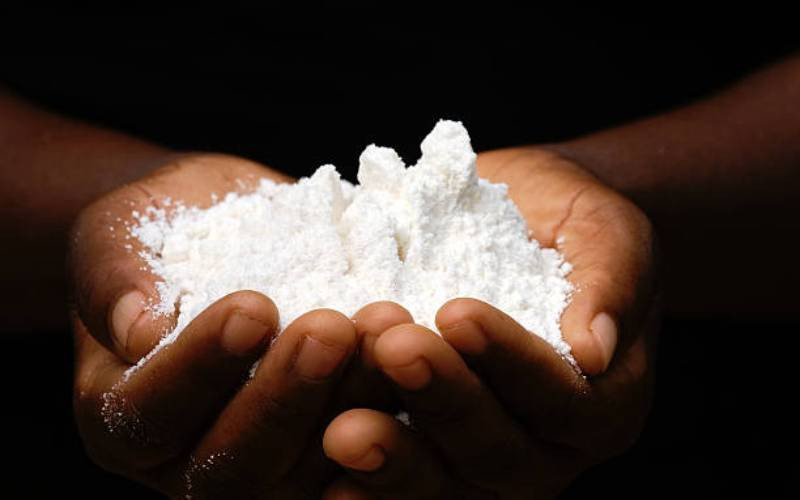
Ugali, also known as cornmeal, is a popular staple food in Kenya.
Prices of maize flour have been skyrocketing with the government attributing the high prices to a maize shortage in Kenya.
On Saturday, August 13, Agriculture Cabinet Secretary Peter Munya suspended the Sh100 maize flour subsidy programme due to lack of sufficient funds from the treasury.
"As you are aware, the government through this Ministry and other key stakeholders has been implementing the ongoing 'Maize flour subsidy program' in partnership with conracted millers under a Presidential Executive Order. However, due to inadequate exchequer releases from the National Treasury, it has been decided that, the Maize Flour Subsidy program be suspended with immediate effect," reads the statement.
49 million bags
Economists estimated that Kenya's population needs at least 49 million bags of maize yearly to sufficiently satisfy ugali needs in the country, but only 35 million bags in the country were available before the importation window was opened on July 1.
On Wednesday, July 20, President Uhuru Kenyatta attributed the suppressed production to poor weather, the rise in cost of production and a rise in food prices across the globe. The maize shortage in Kenya led to a sharp increase in the prices of maize flour - from an average of Sh120 for a 2-kg packet of maize flour to Sh230.
Despite a subsidy programme aimed at reducing the prices of 2-kg maize flour, a spot-check by The Standard shows the prices remain high in most retail stores across the country.
Ugali nutritional value
Nutritionists say ugali, being a carbohydrate, is a source of energy. Whole grain ugali has a low glycaemic index (GI).
According to the UK's National Health Service (NHS), the GI is a rating system for foods containing carbohydrates; it shows how quickly each food affects your blood sugar (glucose) level when that food is eaten on its own.
"Carbohydrate foods that are broken down quickly by your body and cause a rapid increase in blood glucose have a high GI rating," says the NHS.
So, the whole grain ugali, which has a low GI, is absorbed slowly. This ensures that your stomach remains full for long. It also helps prevent obesity, as well as manage diabetes. The whole grain ugali is, thus, suitable for people living with diabetes.

Ugali from refined flour, which is being consumed by a majority of Kenyans, has a high GI rating.
"It is digested faster and absorbed quickly. This causes a spike in blood glucose and therefore not good for people living with diabetes," Vivian Odhiambo, a nutritionist, writes on nutrinformation.com. Ugali is also a good source of fibre, which helps in preventing constipation, effective blood sugar balance, and the management of diabetes.
Nutritionist Odhiambo says ugali is also a documented source of Vitamin B. "Ugali is a good source of B-vitamins, especially Thiamin (B1), riboflavin (B2), and Niacin (B3). It also contains some Folate (B9) which is needed especially by pregnant women," she says in her journal.
According to Medical News Today, B-vitamins are important for making sure the body's cells are functioning properly. "They help the body convert food into energy (metabolism), create new blood cells, and maintain healthy skin cells, brain cells, and other body tissues," says the health website.
Ugali is rich in minerals including calcium, iron, sodium, magnesium, selenium and zinc, which help in bone and teeth development, haemoglobin formation, growth regulation, regulation of acid-base balance in the body as well as energy metabolism.
It is important to note that minerals and vitamins in maize flour reduce with the storage period. Always check the date of manufacture, buy the latest bag of flour and use it soon.
Direct sunlight speeds up the loss of added minerals and vitamins. It is, therefore, advisable that you always keep your flours away from direct sunlight.
Science shows that the maize grain is made up of three parts - the pericarp or bran, endosperm and the germ.
The bran, which is the outer protective layer contains approximately 86 per cent of all the fibre in the grain, the B-vitamins, minerals and antioxidants.
The endosperm contains starch and proteins, while the germ provides more than 70 per cent of all the minerals in the grain and holds most of the vitamins, healthy oils and some proteins.
The concentration of essential nutrients decreases with the degree of milling.

Maize milling can be done in three stages - grade one, two and three, with grade one having almost all the pericarp and germ removed. Most of the flour consumed in Kenya is grade one.
Ugali made from highly refined flour is digested faster, raises the blood sugar level equally fast and has shorter satiety.
A person who eats refined ugali often suffers a sudden rise and drop in blood sugar levels, gets hungry often and consumes fewer nutrients, which increases his risk of dietary-related conditions.
Low consumption of whole grain maize, which has a low GI, has been identified as one of the leading contributors to rising cases of non-communicable diseases and dietary-related deaths.
Globally, consumption of whole grains is at 23 per cent of recommended level, says a Lancet report.
So, with the high prices of maize flour in Kenyan retail stores, are there cheaper alternatives to ugali - with equal nutritional value? The answer is yes.
They include sorghum, finger millet, cassava, rice or hominy grits.
For instance, a kilogramme of cassava goes for Sh45 in many rural retail stores. If it's grounded into flour, the value addition pushes the price up. However, the cost of milling in rural settings remains low compared to the urban centres, where the final product could cost you up to Sh120 for a kilogramme of cassava.
The prices of the other alternatives to maize flour - sorghum, rice and millet - also remain relatively low.
 The Standard Group Plc is a multi-media organization with investments in media platforms spanning newspaper print
operations, television, radio broadcasting, digital and online services. The Standard Group is recognized as a
leading multi-media house in Kenya with a key influence in matters of national and international interest.
The Standard Group Plc is a multi-media organization with investments in media platforms spanning newspaper print
operations, television, radio broadcasting, digital and online services. The Standard Group is recognized as a
leading multi-media house in Kenya with a key influence in matters of national and international interest.











